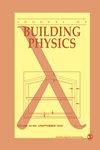Drainage of infiltrated rainwater in wall assemblies: Test method, experimental quantification, and recommendations
IF 1.4
4区 工程技术
Q3 CONSTRUCTION & BUILDING TECHNOLOGY
引用次数: 0
Abstract
Drainage reduces the amount of water able to infiltrate toward the interior of wall assemblies. However, a portion of the infiltrated water remains in the assembly after drainage has occurred. The degree to which this retained portion of water affects the durability of the wall assembly can be evaluated by means of hygrothermal simulations. However, the number of studies reporting information on the retention percentage that can be applied as input for hygrothermal simulations and on the drainage performance of wall assemblies is, in general, quite limited. Therefore, an experimental study was developed, to assess governing test methods to evaluate drainage characteristics and to quantify retention of water in wall test specimens having various cavity widths and incorporating different drainage materials. It was concluded that apart from the absolute amount of retained water, the lateral spreading of water in the cavity and the overall wetted area, should also be considered, thereby resulting in reporting the retained amount relative to the wetted area. The latter values provide more detailed information on the behavior of water in the cavity. Additionally, it was concluded that a clear cavity of 1 mm can drain water more efficiently than a cavity of 10 mm. As well, the surface texture of drainage materials affected the spreading and retention of water within the cavity and the use of a drainage mat in the cavity resulted in an increased relative retention but a reduced lateral spreading of the water.墙组件中渗透雨水的排水:测试方法、实验量化和建议
排水减少了能够渗透到墙组件内部的水量。然而,在排水发生后,仍有一部分渗水留在组件中。这种保留部分的水对管壁组件耐久性的影响程度可以通过热湿模拟来评估。然而,报告可作为湿热模拟输入的保留百分比信息和关于墙组件排水性能的研究数量通常相当有限。因此,开展了一项实验研究,以评估评估排水特性的控制试验方法,并量化具有不同空腔宽度和采用不同排水材料的壁试件中的水潴留。由此得出结论,除绝对保水量外,还应考虑水在空腔内的横向扩散和总体湿润面积,从而报告相对于湿润面积的保水量。后一个值提供了关于水在空腔中的行为的更详细的信息。此外,还得出结论,1毫米的空腔比10毫米的空腔更有效地排水。同样,排水材料的表面纹理影响了水在空腔内的扩散和滞留,在空腔中使用排水垫导致水的相对滞留增加,但减少了水的横向扩散。
本文章由计算机程序翻译,如有差异,请以英文原文为准。
求助全文
约1分钟内获得全文
求助全文
来源期刊

Journal of Building Physics
工程技术-结构与建筑技术
CiteScore
5.10
自引率
15.00%
发文量
10
审稿时长
5.3 months
期刊介绍:
Journal of Building Physics (J. Bldg. Phys) is an international, peer-reviewed journal that publishes a high quality research and state of the art “integrated” papers to promote scientifically thorough advancement of all the areas of non-structural performance of a building and particularly in heat, air, moisture transfer.
 求助内容:
求助内容: 应助结果提醒方式:
应助结果提醒方式:


